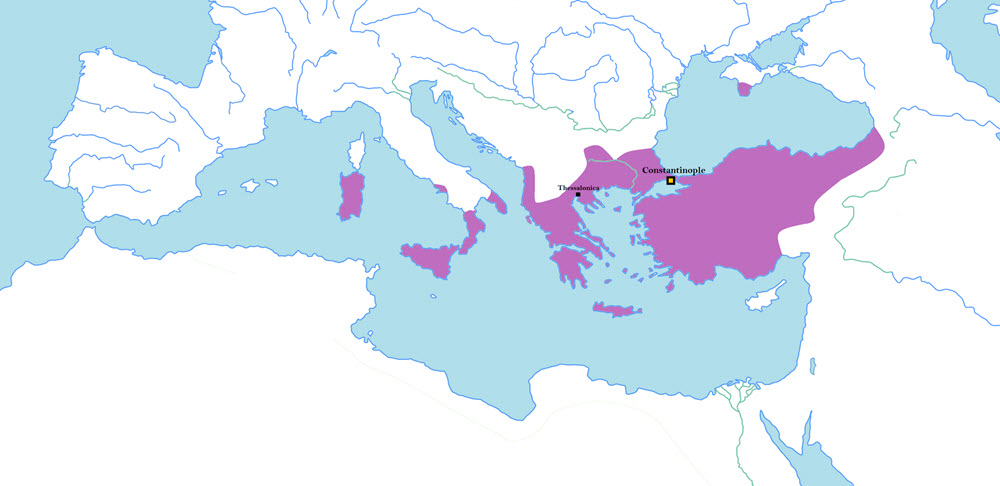Contents
The Byzantine Empire is also known at the Eastern Roman Empire, since it was the continuation of the Roman Empire. As the Western Roman Empire fragmented and fell in the 5th century AD, the Eastern Roman Empire survived and lasted for an additional thousand years, until it was conquered by the Ottoman Empire in 1453.
During most of these thousand years, the Byzantine Empire had the most powerful military force in Europe, and it was also Europe´s largest economy and a highly influential cultural force.
Important languages for the Byzantine Empire was Late Latin and Koine Greek, until the early 600s AD, and then Medieval Greek from the 7th century and onward. Although many of the old Roman traditions were maintained in the Byzantine Empire, it was oriented towards Greek rather than Latin culture. The state religion was Eastern Christianity, followed by Eastern Orthorodyx (after the Schism of 1054). During the reign of Heraclius (610-641), the empire´s administration and the military was restructured, and Greek was adopted as the official language instead of Latin.

Background
The first division of the Roman Empire took place in 286 AD, and it was followed by the final East-West division in 395. Even though the decline of the Western Roman Empire was a long process, the 4th of September 476 AD is usually seen as the official end of the empire since this is when its last emperor Romulus Augustus was deposed and the soldier Flavius Odoace became King of Italy. After this, the only continuation of the Roman Empire was the Eastern Roman Empire – the Byzantine.
The borders of the Byzantine Empire
The borders of the Byzantine Empire changed many times, as the Empire went through cycles of decline and recovery during that long era that stretched from the final East-West division in 395 and the Ottoman Empire´s conquest of the Byzantine Empire in 1453.
The Byzantine Empire attained its largest geographical size during the reign of Justinian I (r. 527-565), as Justinian I reconquered significant parts of the Mediterranean coast that had once been included in the Roman Empire, including Italy and the city of Rome, and parts of northern Africa.
During the first three decades of the 7th century, the Empire´s was weakened by the Sasanian War, and before the century was over it had lost both Egypt and Syria to the Arab caliphate.
A new cycle of expansion took place during the Macedonian dynasty of the 10th and 11th century, when the Empire went through the Macedonian Renaissance.
After being defeated at the Battle of Manzikert in 1071, the Empire lost large tracts of Asia Minor to the Seljuk Turks, and this paved the way for the establishment of Turkish settlements in Anatolia.
The Komnenian restoration brought new strenght to the Empire, both financially and military, and the territory expanded again. This period began with the accession of Alexios I Komnenos in 1018 and ended with the death of Andronikos I Komnenos in 1185. During the period, Constantinople recaptured its position as the wealthiest city of Europe.
Catholic crusaders sacked Constantinople in 1204 as a part of the fourth crusade, and some of the territories of the Empire became Latin realms. Constantinople was reconquered by Michael VIII Palaiologos in 1261, but the Empire never recaptured its former strenght. During the last two centuries of the Empire´s existence, it gradually lost a lot of land to the Ottomans.
The Byzantine Empire ended with the Fall of Constantinople in 1453, when the city was taken over by the Ottoman Empire.
Some successor states remained for a few years. The last one of them, Empire of Trebizond, was conqured by the Ottoman Empire in 1461.
Why is it called the Byzantine Empire?
The Byzantine Empire is named after the city Byzantium, also known as Byzantion.
The citizens of the empire did not call it the Byzantine Empire; they simply saw their homeland as a continuation of the Roman Empire and considered themselves Romans. The empire was known as Imperium Romanum in Latin and Basileía Rhōmaíōn in Greek. The term Byzantine Empire is a later invention, used for the first time in the 16th century, when the empire no longer existed.
The city Byzantion – Byzantium – Constantinople – Istanbul
Byzantium was a Greek city during classical antiquity, and it eventually became the capital of the Byzantine Empire. In late antiquity, it was renamed Constantinople in honor of Constantine the Great. Constantine the Great made it the new capital of the whole Roman Empire in the year 324 AD.
Constantinople was the capitial of the Byzantime Empire from 396 to 1204, and then again from 1261 to 1453. Why the gap? Because in 1204, Catholic crusaders (the 4th crusade) established the Latin Empire. In 1261, Constantinople was reconquested by Michael VIII Palaiologos.
From the mid-5ht century to the early 13th century, Constantinople was the largest city in Europe. Many languages were spoken in the city, but it remained primarily Greek-speaking until after it was conquered by the Ottoman Empire in 1453 AD.
Notable emperors of the Byzantine Empire
| • 330–337 | Constantine I |
| • 395–408 | Arcadius |
| • 527–565 | Justinian I |
| • 610–641 | Heraclius |
| • 717–741 | Leo III |
| • 976–1025 | Basil II |
| • 1081–1118 | Alexios I |
| • 1259–1282 | Michael VIII |
| • 1449–1453 | Constantine XI |
This article was last updated on: July 7, 2020


Recent Comments